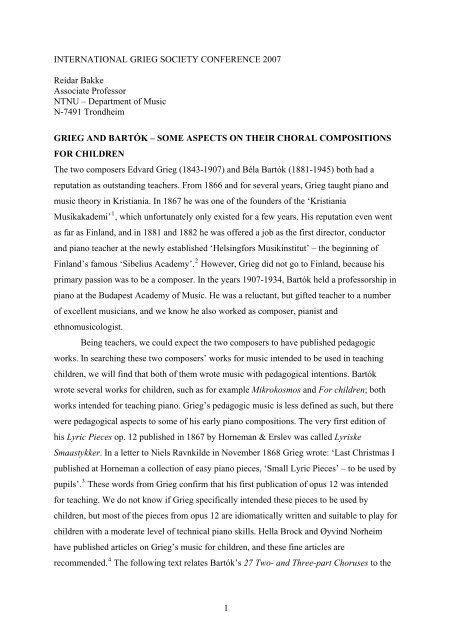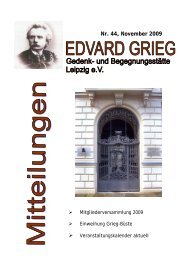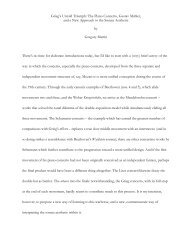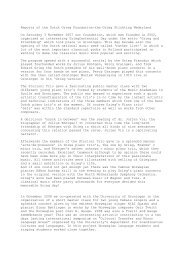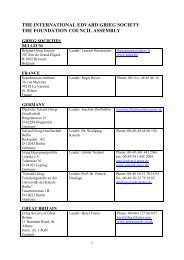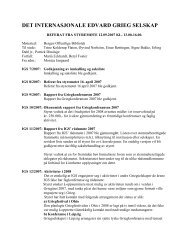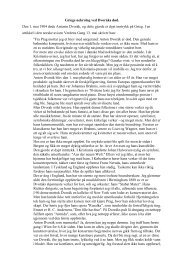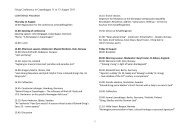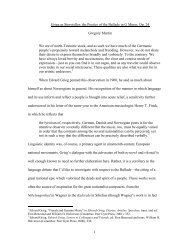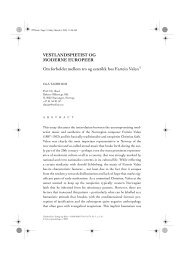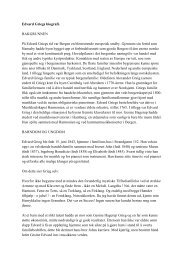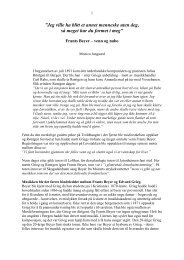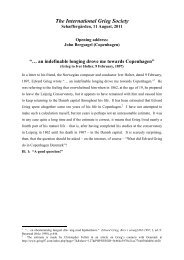Reidar Bakke - paper 2007 - Grieg Society
Reidar Bakke - paper 2007 - Grieg Society
Reidar Bakke - paper 2007 - Grieg Society
Create successful ePaper yourself
Turn your PDF publications into a flip-book with our unique Google optimized e-Paper software.
would sound remarkable with children’s voices. Upon my return to Troldhaugen, I really lookforward to arranging them’ 7 .When the 1894 version of the opus 61 songs is viewed in light of these quotationsfrom <strong>Grieg</strong>’s letters in 1901 and the fact that his wife was the first to perform them in April1894, we could question whether <strong>Grieg</strong> originally intended his seven songs to be sung bychildren. The songs in the 1894 version published for voice and piano would at least beappropriate for children’s listening. In a letter of September 1894 <strong>Grieg</strong> wrote: ‘The songs aremeant to be sung by youths, and also in schools’ 8 . Later that same year he experienced hisFatherland Hymn being performed in a concert hall. He did not like this, writing: ‘This songmust be sung in school and in the home, and not in the concert hall’ 9 . These two <strong>Grieg</strong>quotations indicate that the Fatherland Hymn as well as the six other songs from the 1894version were intended to be sung at least by youths in school. The melodies were shortly afterprinted in school books, and <strong>Grieg</strong> later arranged the songs for two voices. In 1901 the sevensongs were arranged for three-part children’s choruses, and from this point on there is nodoubt that all seven songs were intended to be performed by children.Some of the melodies have been more popular than others. The six songs named TheOcean, The Christmas Three, Farmyard-Song, Good-night Song for Dobbin, The NorwegianMountains and Fatherland Hymn have through the years been printed in several school songbooks, such as books published by Sandvik (The Ocean, Fatherland Hymn, Farmyard-Song),Søraas (The Cristmas Three, Good-night Song for Dobbin, The Norwegian Mountains,Fatherland Hymn) and Berg 10 (Fatherland Hymn, The Norwegian Mountains, The ChristmasThree). Good-night Song for Dobbin has probably been the most popular one of all. <strong>Grieg</strong>’smelody to Fisherman’s Song has not been found in any school song book 11 , presumablybecause this song has been sung with the more popular melody composed by Ole Olsen. Wemust also mention that Good-night Song for Dobbin is often sung to a Norwegian folk tune,and that The Christmas Three is mostly sung to the more famous melody composed byDanish C. E. F. Weyse.While many of <strong>Grieg</strong>’s other choral works – such as his Album for Male Voices op. 30– are arrangements of Norwegian folksongs, all seven pieces in his Children’s Songs op. 61have their own melodies, even though most of the melodies are composed in a folk song style.Among the seven three-part choruses, Farmyard-Song, Good-night Song for Dobbin and TheNorwegian Mountains have all been especially popular in children choirs during the middleand the last part of the 20 th century. 12 The reason behind the popularity of the three particularchoruses is probably the interesting texts with pedagogical intentions and aspects in3
combination with <strong>Grieg</strong>’s good melodies and arrangements, a combination which will appealto children even today. At the time these songs were composed, the texts were taken frommodern Norwegian lyric poetry. The popularity of Rolfsen’s book, which was published innumerous editions, made the texts function almost like folk song texts, however. Farmyard-Song is originally taken from Bjørnson’s novel Arne. Bjørnson was a very popular author inthe first part of the 1900s, and <strong>Grieg</strong> loved Bjørnson’s texts. Good-night Song for Dobbin andThe Norwegian Mountains were both written by Rolfsen himself. <strong>Grieg</strong> was not particularlyfond of Rolfsen’s drama texts, but he was very fascinated by his poems for children. In a letterfrom 1906 he wrote: ‘…his [Rolfsen’s] dramas are of little value, but he has great lyricaltalent. When his fantasy dwells upon his childhood, he always comes through’ 13 . Also,Rolfsen really did succeed in making the lyric poetry appealing; using a combination ofwords, rhythms, atmospheres, and pedagogic aims in such a way that the texts, as previouslymentioned, are quite interesting to children even today.A few comments on the three above-mentioned choruses from <strong>Grieg</strong>’s Children’sSongs op. 61: 14 Bjørnson’s Farmyard-Song text is a typical children’s text, inviting thechildren to play, and <strong>Grieg</strong> takes the children into this childish world with his melody andrhythm and underlines the cheerful atmosphere. The song has a ternary form (ABA’) with themelody of the first part A mostly in broken triads. The melody of part B moves in greaterintervals, starting in bar eight with a characteristic major nine, followed by a minor seven,which is repeated twice. Both the nine and the sevens are reminiscent of traditional cattle callmelodies sung by milkmaids. The harmonies of the first part A are on tonic level, while theharmonies of the second part B are on dominant level. In the repetition part A’ <strong>Grieg</strong>introduces a touch of Mixolydian mode with the F-tone of soprano II. The last part also has acoda or a kind of tail, which is a variation of the main theme.Rolfsen’s text Good-night Song for Dobbin takes the children to a scene of gettingready for the night. <strong>Grieg</strong>’s beautiful melody has the rocking, sleepy rhythm of a lullabysuitable for being sung by the cradle. The melody has a varied strophic form with four phrasesin each verse. The characteristic theme in F tonic is striving upwards in pentatonic-likesequences. The varied second part from bar nine on dominant C is primarily moving upwardsin sequences of broken thirds. The B flat-tone of soprano II in the very last part creates asecondary dominant to the subdominant B flat and a feeling of a closing plagal IV-I cadenceat the end, which also gives this song a touch of Mixolydian mode.With The Norwegian Mountains Rolfsen takes the children on a geographical journey,hiking through the highest and most famous mountains of Norway. <strong>Grieg</strong> has made the song4
in the natural way these children from the suburban schools produce their voices, that remindsone of the unspoilt sound of peasant singing.’ 17In his 27 Two- and Three-part Choruses 18 Bartók did not make folk songarrangements as he had often done in earlier choral works. Instead, he gave every chosen textits own melody. However, most of the melodies are still reminiscent of folk songs. A fewcomments on three songs from Bartók’s 27 choruses: Choosing of a Girl is the third song inthe second volume. The atmosphere is a bit introverted, reflecting the serious situation amongchildren when choosing a best friend. The form is ternary (ABA’), a form which can also befound in many of Bartók’s smaller works. The song is written in G major, with chords oftenchanging, mostly in V-I progressions. The B part starts in bar 16 with imitation, and the meterchanges. The F of the lowest voice in bars 26, 31 and 32 gives the B part a touch ofMixolydian mode.Thieving Bird is the fourth song of the second volume. The song has a cheerfulatmosphere and is written in bar form (AA’B). The first part of the song is canon-like withimitations, whereas the last part starting in bar 25 has a homophonic structure. The song isprimarily written in D Dorian, before turning into D Phrygian at the end of the chorus.Don’t leave me is the first song of the third volume and is written as a two-part modalcanon. The first part starts in C Lydian, the second part from bar 15 moves to E Dorian, thethird part from bar 25 starts in D Dorian, and the last part returns to C Lydian. The tempo ofthe two-part chorus is molto tranquillo, reflecting the earnest atmosphere of the text.When Bartók’s 27 choruses are compared to <strong>Grieg</strong>’s 1901 version of opus 61, wecould ask whether their children’s choruses represented new trends in their respectivecompositions. <strong>Grieg</strong> did not follow up his opus 61 with other choral works for children’svoices. After opus 61 <strong>Grieg</strong> returned to his earlier paths in writing piano pieces, romances,works for mixed choruses, etc. Bartók did not compose anything else specifically forchildren’s voices either, but he did start a trend in that he began composing in a way that waseasier to perform, as we can see in his Music for Strings, Percussion and Celesta from 1936,for example. Still, it is possible to identify certain parallels between the two composers andtheir works for children’s voices. Most of <strong>Grieg</strong>’s and Bartók’s choral works were written foradult voices. They were both mature composers when they first started writing their children’schoruses, and both of them expressed their fascination for and saw new possibilities in thesound of children’s voices. <strong>Grieg</strong>’s 1901 version of his Children’s Songs op. 61 and Bartók’s27 Two- and Three-part Choruses are music written specifically for and intended to beperformed by children. The choruses were intended to be used in schools and in children’s6
choirs and the works became popular in their respective homelands. While <strong>Grieg</strong> and Bartókoften used folk song melodies from their own countries in their earlier compositions, the twomentioned works are composed with their own unique melodies. However, both the songs in<strong>Grieg</strong>’s Children’s Songs and Bartók’s 27 Two- and Three-part Choruses are composed in afolk song style. Bartók used modality in his choruses, and we can also find a touch ofmodality in <strong>Grieg</strong>’s choruses. Both composers wrote their songs in traditional forms. Theywere both inspired by texts when composing. Bartók chose folk song texts for his choruses,while <strong>Grieg</strong>’s chosen texts in a way functioned like folk song texts because of the popularityof Rolfsen’s reader – the book was re-printed numerous times. In their music both composersbrilliantly reflected the atmospheres given in the texts. In considering these parallels between<strong>Grieg</strong> and Bartók in their writings for children’s voices, one could ask whether there is aconnection between <strong>Grieg</strong>’s opus 61 and Bartók’s 27 Two- and Three-part Choruses, but thisquestion is impossible to answer. Bartók possessed great creativity and a strong artistic abilityto compose works in his own musical language. We do not know whether he was familiarwith <strong>Grieg</strong>’s choruses, and it is difficult to find any influences of <strong>Grieg</strong> in his 27 choruses. 19If anything were to influence Bartók’s 27 choruses, Bartók was, as previously mentioned,inspired by the success of his friend Kodály’s choruses for children. But we also know Bartókwas fascinated by <strong>Grieg</strong>. Shortly before Bartók’s death in 1945, the Hungarian conductorAntal Dorati visited him in his home in New York. The two musicians talked about <strong>Grieg</strong>,and Bartók said: ‘We have to be serious about <strong>Grieg</strong>. He was a very important composer. Didyou know he was one of the first of us to throw away the German burden and instead turn tothe music of his own people.’ 20 So, even if we can find certain parallels between the twocomposers in their works for children’s choruses, it is impossible to say whether <strong>Grieg</strong>’s opus61 was connected in any way to Bartók’s 27 choruses, but at least we know that Bartóklooked upon his fellow colleague from Norway with the utmost respect.1 <strong>Grieg</strong> founded ‘Kristiania Musikakademi’ together with Otto Winter-Hjelm.2 See letter from <strong>Grieg</strong> to Thyra Neovius (wife of <strong>Grieg</strong>’s friend Edvard Neovius) of November 4 1881, andletter from Leon Borgström (one of the founders of ‘Helsingfors Musikinstitut’) to <strong>Grieg</strong> of March 16 1882.Both letters can be found in the Bergen Public Library.3 <strong>Grieg</strong>, Edvard 1998 (ed. F. Benestad): Brev i utvalg 1862-1907, vol. 2, Oslo (Aschehoug), p. 206.4 About <strong>Grieg</strong>’s music for children, see Brock, Hella 1990: ‘Edvard <strong>Grieg</strong>s Musik für Kinder’ in StudiaMusicologica Norvegica, vol. 16, Oslo (Universitetsforlaget), p. 21, and Norheim, Øyvind 1999: ’<strong>Grieg</strong> sombarnesangkomponist: Barnlige Sange opus 61’ in Studia Musicologica Norvegica, vol. 25, Oslo(Universitetsforlaget), p. 24.5 In 1894 <strong>Grieg</strong> arranged two songs from opus 61 (The Ocean and Fatherland Hymn) in two-part versions. Laterhe also arranged the five other songs in two-part versions. All two-part versions were published together with thethree-part versions in 1901.6 <strong>Grieg</strong> 1998, vol. 1, p. 326.7
7 Ibid., p. 327.8 Ibid., p. 299.9 Ibid., p. 300.10 See e.g. Berg, Mads 1970: Skolens sangbok, Oslo, (Aschehoug), Søraas, Lars 1960: Sangboka, Oslo (Lunde),Sandvik, O. M. 1928-1938: Melodier til Nordahl Rolfsens lesebok, Sandvik, O. M. 1962: Sangbok forskoleungdom, Oslo (Aschehoug).11 A number of different song books have been examined, but here I primarily refer to Nordheim 1999, p. 28.12 Here I refer to concerts with choirs like NRK’s jentekor, Gloppen jentekor, Stord Ungdomskor and Vocinobili.13 <strong>Grieg</strong> 1998, vol. 2, p. 411.14 <strong>Grieg</strong>, Edvard 1977-1995: Complete Works, vol. 17, Frankfurt (C. F. Peters).15 Bartók, Béla 1971: Letters, London (Faber and Faber), p. 237.16 Ibid., p. 238, p. 417.17 Ibid., p. 257, p. 423.18 Bartók, Béla: 27 Two- and Three-part Choruses, Budapest (Editio Musica Budapest).19 A work like <strong>Grieg</strong>’s Peasant Dances opus 72 usually is considered to be a forerunner to some of Bartók’smusic.20 Norges musikkhistorie 1999-2001, Oslo (Aschehoug), vol. 3, p. 22.8


